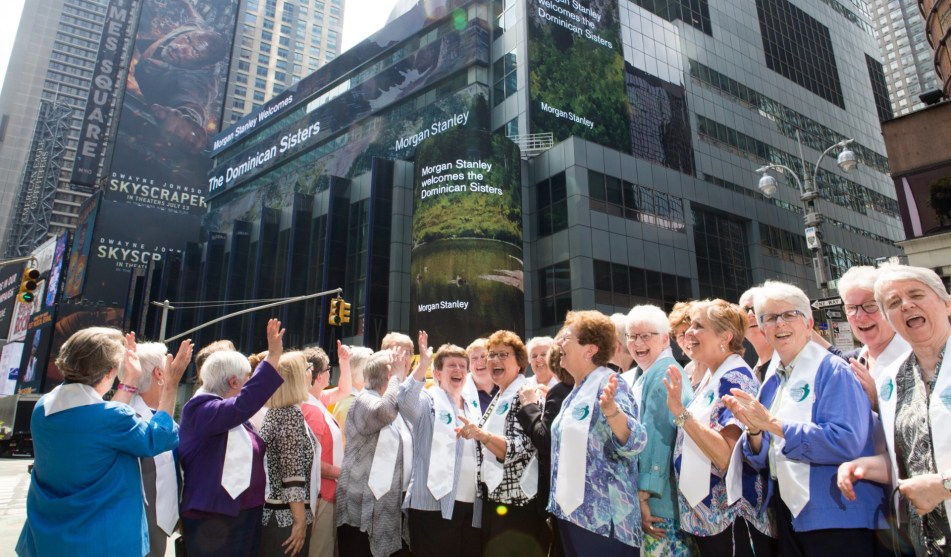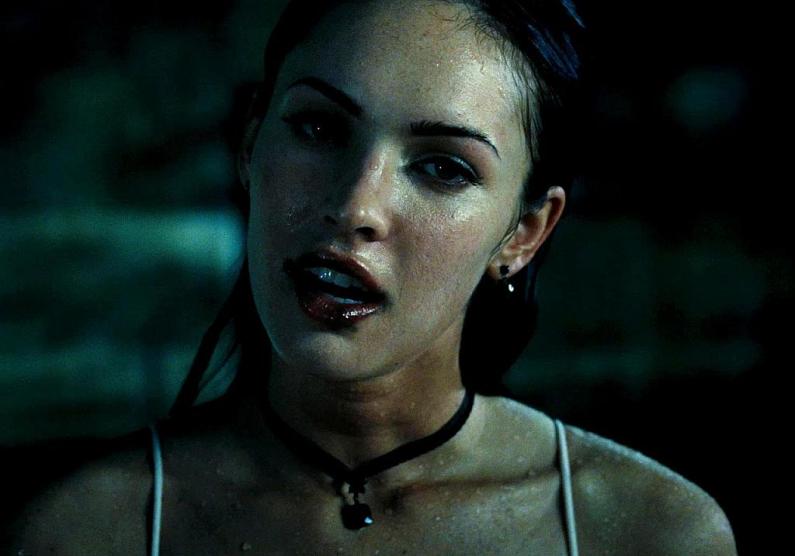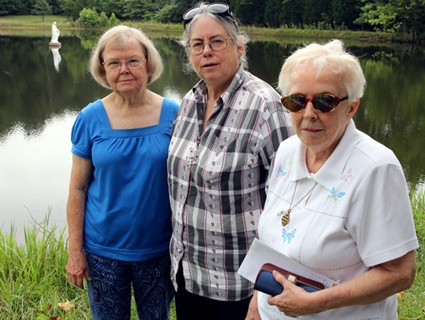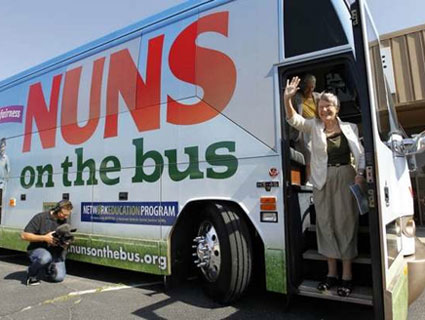Immaculate may appear to be all about evil nuns. In the movie’s grisly opening, four nuns break a runaway sister’s leg. Another holy mob tries to skewer the protagonist, Sister Cecilia, like a shish kebab just after she takes her final vows—and before she unexpectedly becomes pregnant. Halfway through the film, Cecilia catches two sisters slicing off a mouthy novitiate’s tongue. Candles burn, incense wafts, and their habits conceal evil intentions.
But the real villain is the parish priest. A former geneticist who’s found his calling trying to engineer the next messiah, he inseminates Cecilia with DNA pulled from—wait for it—one of the nails used to crucify Jesus Christ. Producer and lead actor Sydney Sweeney said she and the rest of the crew behind Immaculate “never really looked at a lot of nun films.”
It appears that they never really looked at a lot of actual nuns, either. Immaculate is hardly the first horror film to commit this sin. Nuns, with their unmistakable silhouettes, have long been made caricatures by the horror genre, revealing that, long before JD Vance became a VP candidate, society was never comfortable with unmarried, childless women, much less those living communally. The fact that nun horror is most often set in earlier eras—usually back when nuns were sporting habits and chanting in Latin—feels like a middle finger to these women, who had some measure of self-determination in a world long before the Western women’s rights movement.
Tales of satanic nuns are older than film itself. For centuries, the expectations imposed on cloistered women were as constricting as the social roles available to them and the walls surrounding them—and speculation ran wild. Some of these accounts went on to inspire late-20th-century nunsploitation films, like Convent of Sinners in 1986, which laid the foundation for modern movies like Immaculate.
These days, nuns are an endangered species. The numbers peaked at about 180,000 American sisters in 1965, but declined to fewer than 36,000 by 2023. In 2009, more than 90 percent of American sisters were age 60 or older. While nun characters have appeared in films of all stripes, from a soul-searching novice in Ida to Whoopi Goldberg’s comedic turn in Sister Act, the horror genre seems especially, and lucratively, fixated on them. The Conjuring series, which includes The Nun and The Nun II, is one of the highest-grossing horror franchises of all time. Nuns also star in—or haunt—such recent releases as The First Omen (2024), Sister Death (2023), Deliver Us (2023), and Consecration (2023).
“[Nuns] are figures that, for Americans, are very other,” said Ryan Duns, a Jesuit priest and author of the new book Theology of Horror. “And there’s a fascination with that.” Yet nun horror films reflect society’s larger discomfort with these independent women and conveniently ignore that for many real-life nuns, forgoing secular marriage and childbearing has freed them to perform invaluable academic, artistic, and social justice work.
Today’s nun horror can best be understood through its progenitor: nunsploitation. This genre, often as blood-soaked as it is pornographic, was popularized in ’70s Europe, largely as a critique of the Catholic religion. Whereas the church believed that vows of poverty, chastity, and obedience could bring women closer to God, these films seemed to posit that such strictures were more likely to turn women into wanton, slutty psychopaths.
Italian director Joe D’Amato clearly had a score to settle in his 1986 flesh flick Convent of Sinners, which he made under the name Dario Donati. The film liberally draws from Denis Diderot’s 18th-century novel La Religieuse, a seminal work of anti-Catholic criticism. Convent of Sinners is one of three major film adaptations, with Jacques Rivette’s The Nun (1966) and Guillaume Nicloux’s The Nun (2013). Rivette’s take is considered an arthouse classic, and Nicloux’s premiered in competition at the Berlin International Film Festival, but Convent of Sinners aimed lower. A foremother of today’s nun horror, the film features exorcism, sexual hysteria, and lots of ominous harpsichord, plus a demon-purging douche.
For many women in the past, “marriage, prostitution, and the convent were about the only choices.”
Unlike today, when evil nuns tend to appear in the background, they’re often front and center in early nunsploitation films. In Convent of Sinners, heroine Susanna faces off against a predatory lesbian abbess and her scorned second-in-command. The former wants to show Susanna the ways of the flesh; the latter is so jealous that she poisons Susanna and stages her alleged possession. An opening intertitle quotes La Religieuse: “What need has Christ of so many foolish vergins [sic] and the human race of so [many] victims?”
La Religieuse excoriated cloistered life as repressive and intolerable. According to Craig A. Monson, author of the 2010 book Nuns Behaving Badly, there was some truth to that assessment. For many women in the past, “marriage, prostitution, and the convent were about the only choices,” Monson explains, and each came with (usually male) supervision. A woman’s purpose was dictated either by her husband, her male relatives, a brothel owner, or the church. The Council of Trent in the mid-1500s, which called for “the enclosure and safety of nuns,” stipulated that unless approved by a bishop, a nun could not “go out of her convent, even for a brief period, under any pretext.” There was no such thing as a mental breakdown for being shut away against your will, but there was such a thing as demonic possession.
Still, while filmmakers like D’Amato may have had some valid points about Catholic repression, they loved to show as much female nudity and sexual violence as possible while making them. Convent of Sinners opens as Susanna is graphically raped by her father and ends with a still of her lifeless, topless form. All the frames in between feature more naked breasts than a French beach in June. As a novice, Susanna sheds her secular clothes and puts on special underwear in front of the entire convent. Later, in a bathing area, the sisters frolic naked, splashing each other with water and giggling. While two nuns are doing laundry, one laughs to her companion, “Whenever I have to wash these, I think of dirty habits.”
Many nunsploitation films masqueraded as sex-positive propaganda, but leave it to men to fetishize a population of women who have opted out of sexual life altogether. (A nunsploitation sex scene is comparable to two “sexy nun” costumes from your local Spirit Halloween come to life and robotically feeling each other up.) These films also serve as anti-Catholic vehicles, casting nuns as repressed to the point of psychosis (or, gasp, lesbianism). The church might not look great, but neither do these filmmakers’ opinions of women. The best sisters in these films end up dead like Susanna, doe-eyed martyrs to a supposedly progressive cause.
Sigmund Freud famously posited that certain men are unable to be aroused by the women they love and unable to love the women who arouse them. This “psychical impotence,” more commonly known as the Madonna-whore complex, sums up the cinematic nun nicely. She is either too pure, forced by some evil external force to the brink of ruin, or, as with the oft-used Mother Superior trope, she is the one doing the ruining. The moral of the Conjuring franchise—which wildly fictionalizes the lives of Ed and Lorraine Warren, two real-life Catholics and paranormal investigators—is that no evil can truly harm those with enough faith in the Christian God. The franchise’s The Nun and The Nun II have become easily the most successful nun horror films, grossing more than $630 million to date. While it’s refreshing to see our pious protagonists not being brutalized, sexualized, or exorcised, these women are barely human in an entirely different, even nostalgic way: They’re practically divine.
This franchise seems to be an effort to memorialize the days when nuns were shut away and, quite literally, holier than thou. “Catholicism has not historically modernized the way that other religious traditions have. There’s something atavistic about it,” Duns, the Jesuit priest and academic, told me when I asked why horror movies are still so obsessed with habit-sporting nuns and collared fathers. “These are people who dwell in our midst, but they’re tied to a past we don’t quite understand.” He pointed out that this must have felt especially true after the reforms of the Second Vatican Council in 1965, which, in an attempt to collapse the distance between clergy and laypeople, dictated, among other things, that Mass could be conducted in vernacular languages and nuns’ traditional floor-length habits could be jettisoned. “All of a sudden,” Duns noted, “you show up to Mass the next week and the priest is facing you, he’s now speaking your language, and the liturgy that had composed your sense of space, time, and the sacred has evanesced.” So why does the big screen always show habited nuns chanting in Latin?
The Nun films, set in the decade before Vatican II, seem to long for these bygone rituals while exploiting them. In the first film, one nun tormented by Valak—a demon who manifests as a nun—is so pious that she would rather kill herself than be a vessel for evil. Another nun, Sister Irene, takes her vows to become “a true bride of Christ,” and is able to weaponize an actual vial of Jesus’ blood. The Nun II takes this even further. Turns out Sister Irene is a direct descendant of St. Lucy, the patron saint of the blind, and the visions she’s been having are holy rather than delusional. (Convenient!) This time, the power of her prayer turns barrels of wine into demon kryptonite, Christ’s blood.
Because convent life “is this weird, sealed, matriarchal thing,” Elle Carroll, the author of Vulture’s “18 Essential Nunsploitation Films,” tells me, “there’s this automatic assumption that insane things must be going on. They must be up to something, be it truly everything from demonic possession to silly, softcore-porn lesbianism.”
In reality, the something many nuns have gotten up to over the centuries is innovation, unencumbered by wifely duties or childbirth. Intentionally or otherwise, Catholic nuns were the original female separatists, and convents were often the best option for self-sufficient women. Lucrezia Orsina Vizzana flourished as a singer, organist, and composer from within her convent in 17th-century Italy. Hildegard of Bingen, who made groundbreaking contributions to music and medicine in the 12th century, was a Benedictine nun. The 20th-century artist Corita Kent, who joined the Sisters of the Immaculate Heart of Mary in 1936 at age 18, made indelible contributions to pop art with her political serigraphs and advocated for Catholic progressive reform during Vatican II.
“They must be up to something…from demonic possession to silly, softcore-porn lesbianism.”
Their self-government opened opportunities to develop scholarly, artistic, or technical pursuits that Monson, the author of Nuns Behaving Badly, says “would not have been readily available in the world.” He acknowledges that some nuns “got their jollies out of being super-pious,” but others were “more intellectual, whether it was in music or in writing or in becoming accountants—even running the finances” for their convents.
The Roman Catholic Church is still one of the biggest charitable organizations in the country, and without its legions of female volunteers, these efforts would grind to a halt. Many nuns see such good works as a specific part of their calling—take the Dominican Sisters of Hope, based just north of New York City, who name “poverty, eco-justice, civil rights, access to health care, and access to education” among their key issues. The St. Louis–based Daughters of Charity work in health care, prisons, and social services. Pope Francis is reportedly friendly to nuns, but in 2012, the Vatican under arch-conservative Pope Benedict XVI accused the largest umbrella organization for nuns of promoting “certain radical feminist themes incompatible with the Catholic faith.” Their crimes? Voicing support for the Affordable Care Act and, allegedly, mentioning “patriarchy.”
Perhaps nuns terrorize the big screen because their social role is so complex. In a society where the value of exclusively female spaces remains confusing, nuns are reduced to objects of fear (or derision). In nun horror, elderly nuns are always the most monstrous. The nubile protagonists in Immaculate and Convent of Sinners are preyed upon for their fertile wombs and pert physiques, and that the predators are their mothers superior speaks volumes.
In a society where churchgoing is on the decline, horror movies may serve a unique purpose. Duns, the Jesuit priest and academic, said he’s witnessed rampant religious alienation among his undergraduate students, but the horror genre offers a novel outlet for existential angst. “Interpersonal communication and shared ritual has been displaced, and I think relocated into horror,” he told me, where “you confront mortality, evil, the meaning of life.” Monsters—psychopathic serial killers, vampires, malicious ghosts—serve this purpose, but assigning that baggage to an actual class of women suggests a deeper problem. Few other professions feature so heavily in horror films, but why? Because these women used to dress strangely? Because they have faith? Because they’ve opted out of the usual marriage-and-children script?
With habit reform nearly 60 years in the rearview mirror and many nun horror films painting Catholics as godless hypocrites, it’s hard not to feel as though that last reason is the one with the most sticking power. After all, if Cecilia had just stayed in the Midwest and done the “normal” thing, there wouldn’t be a movie, would there?

















